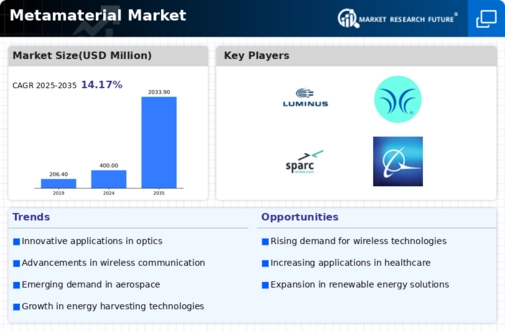Top Industry Leaders in the Metamaterial Market

Market Segmentation and Strategies:
The metamaterial market can be broadly segmented by type (electromagnetic, optical, acoustic) and application (aerospace & defense, consumer electronics, energy & power, medical). This segmentation dictates the strategies adopted by players, with some focusing on specific niches like stealth technology for defense applications, while others pursue broad-based solutions for consumer electronics.
Key Strategies:
-
Innovation and IP Acquisition: Leading companies like Kymeta and Meta Materials Inc. are investing heavily in R&D, aiming to develop novel metamaterial designs and secure intellectual property rights. -
Partnerships and Collaborations: Smaller companies often partner with established players or research institutions to access resources and expertise, while large corporations acquire promising startups to bolster their portfolios. -
Vertical Integration: Some companies are opting for vertical integration, controlling the entire value chain from material development to manufacturing of finished products. -
Government Funding: Given the strategic implications of metamaterials, government agencies like DARPA and NASA play a crucial role in funding research and development projects.
Factors for Market Share:
The competitive landscape is still fluid, with no single player dominating the market. Factors influencing market share include:
-
Technological Expertise: Possession of advanced design capabilities and manufacturing know-how is critical. -
Product Portfolio and Application Diversification: Companies with a wider range of solutions catering to diverse applications have an advantage. -
Geographical Presence: Strong presence in key markets like North America and Asia Pacific is crucial. -
Cost and Scalability: Ability to produce metamaterials cost-effectively and at scale is essential for market penetration.
Key Players
August 2023: Metamaterial Inc., a leading developer of metamaterials, announces a strategic partnership with a major telecommunications company to develop next-generation antennas for 5G and beyond networks.
September 2023: Researchers at MIT unveil a new type of metamaterial that can perfectly absorb sound waves, paving the way for quieter transportation systems and noise-canceling devices.
December 2023: A team of scientists successfully demonstrates the use of metamaterials to create an invisibility cloak at terahertz frequencies, opening up exciting possibilities for stealth technology and medical imaging.









